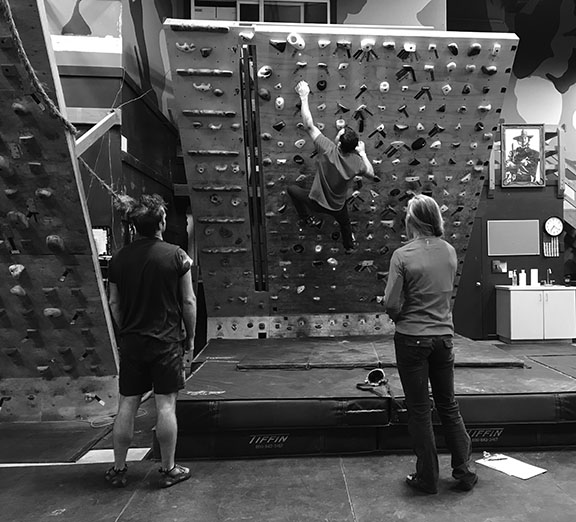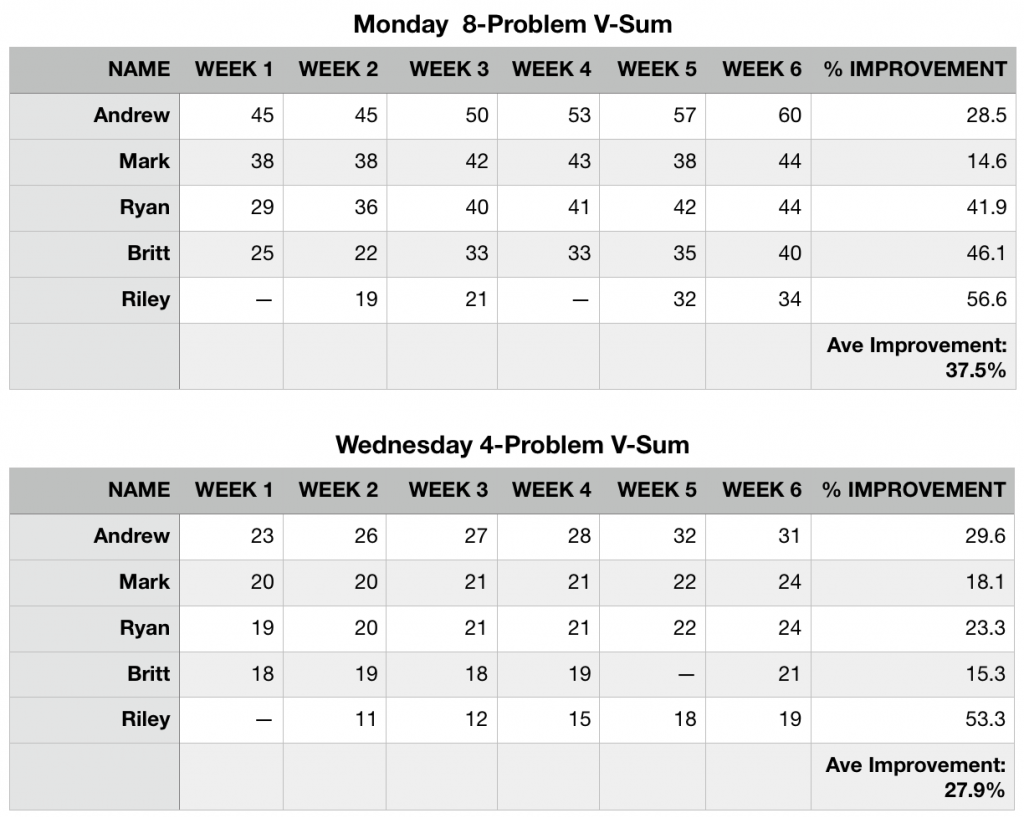
By Rob Shaul, Founder
Each year at our facility in Wyoming we conduct to rock climbing-specific lab rat cycles, one each in the Fall and Spring.
We concluded our Spring 2019 Rock Climbing Cycle last week, and it proved to be one of our most successful in terms of rock climbing fitness and technical ability improvement.
What stands out in this just-concluded cycle is its focus and simplicity.
This was a focused, 4 day/week, 6-Week training cycle. The cycle began with 8 Lab Rats, with 5 finishing the cycle.
Two key elements separated this cycle from others we’ve designed in the past:
(1) Use of Bouldering V-Sum Variations as both a tool to measure improvement, but also a tool to train strength, power, endurance and technical ability.
(2) Focus on Strength as the primary sport-specific fitness element trained.
First, some background on the Bouldering V-Sum, and how we use time under tension for Rock Climb Program design.
V-Sum
I learned the Bouldering V-Sum from Steve Bechtel, a well known and respected rock climbing coach based in Lander, Wyoming, and we’ve deployed this training and assessment tool many times in past rock climbing cycles and program design.
Bouldering problems are rated on a “V” scale, 0-14. A V-1 bouldering problem is at a beginner’s level, and only a handful of climbers can complete a V-14 Bouldering Problem.
The “V-Sum” is an assessment tool which uses a set time period, number of problems and bouldering problem V ratings to assess a climber’s fitness and technical ability.
This cycle deployed two V-Sum Efforts: (1) 50-minute, 8-Problem V-Sum, and; (2) 40-Minute, 4-Problem V-Sum.
For the 50-minute V-Sum, after a short 5-10 minute warm up, the climber is given 50 minutes to climb. At the end of the 50 minutes, the climber gets to add the V-rating of his or her 8-highest bouldering problems successfully completed in the 50 minutes. The climber may climb more than 8 problems, but only the highest 8 problem V-ratings are added together for the final V-Sum.
As an example, a climber successfully climbs 12 problems total in the 50-minute time limit – with the V-Ratings below:
Problem V-Rating
1 V1
2 V2
3 V3
4 V3
5 V4
6 V4
7 V5
8 V6
9 V5
10 V4
11 V5
12 V4
His V-Sum for this 50 minute effort is the sum of the top 8 bouldering problems, which in this example is 4x V4’s (16 points) + 3x V5s (15 points) + 1x V6 (6 points) for a final V-Sum of 16+15+6 = 37.
The 4-Problem V-Sum worked in the same manner – with the differences being a 40-minute time limit, and just 4 bouldering problems counting toward the final V-Sum score.
Maximizing the V-Sum takes a combination of climbing-specific fitness, specifically finger strength, climbing-specific technical ability, and for the 8-problem effort, climbing specific finger strength endurance.
The major limitation of the V-Sum as a training and assessment tool is its requirement either for a bouldering gym, or a Moon Board or similar rock climbing tool which offers multiple bouldering problems using the same holds. The Moon Board specifically uses a smartphone application which connects wirelessly via bluetooth to a set of LED lights under each hold on the Moon Board. This allows climbers to chose light up literally thousands of bouldering problems quickly and easily using the same training board.
MTI has two Moon Boards:
We found that for many beginning and newish climbers, the 40-degree board was too difficult, which is why we purchased and installed the 25-degree board.
One of the benefits of using a Moon Board for the V-Sum is that a single set of problem setters has worked on the individual bouldering problems which gives their V-ratings more consistency. Many bouldering gyms will have multiple problem setters – and this results in inconsistent V-ratings.
The short clip below shows the athletes completing their final 50-minute, 8-problem V-Sum in this cycle:
Why the second, 40-minute, 4-problem V-Sum? The 8-problem V-Sum trains strength, stamina, and technical climbing ability – by doing it at the beginning of the week I was able to get the athletes fresh and rested after the weekend, and use the 8-problem effort as the primary assessment of their fitness and technical improvement as we progressed through the cycle.
I programmed the 40-minute, 4-problem V-Sum on Wednesdays, after two hard days of training prior in an effort to force the climbers to work on technical ability, knowing they would come into the Wednesday effort with pre-fatigued finger strength. My hope was that with tired fingers, the climbers would need to climb better technically, and not rely on strength/fitness, to steadily improve their Wednesday 4-problem V-Sum scores over the course of the cycle.
Time Under Tension and Strength
I’ve written before how MTI’s climbing program design deploys time under tension to differentiate between strength, work capacity, and endurance training. In terms of rock climbing, below is the time under tension breakdown for each fitness attribute:
Attribute Duration
Strength <1 Minute
Work Capacity 1-4 Minutes
Stamina 4+ Minutes
In past climbing cycles, I’ve programmed exercises, drills, and events to cover all three of these fitness attributes, but for this cycle, I only programmed the shorter-duration strength training and did so using two specific exercises:
(1) Constant movement, feet on, campus board intervals, 60 seconds or less.
These are focused, simple, finger strength training intervals using a campus board not to campus, but as a system board. The athletes are allowed to have their feet on the board and are required to constantly move their hands between 2-3 rungs for the allotted work period. For this cycle, we began at 4 rounds of 30-second intervals with 60-second rest efforts (30/60), and rapidly progressed (by Week 3) to 4 rounds of 60-second intervals, with a 60-second rest (60/60).
If the athlete was able to successfully complete 4 rounds of 60/60 rapid movement intervals, we added external weight in a backpack to increase difficulty. My strongest climber finished with 15 pounds backpack.
Between the 4 rounds of campus board work, the athletes completed 5-7 minutes of sandbag getups to give their fingers a break, and also train general fitness.
The clip below shows the athletes completing 60/60 Campus Board rapid movement intervals:
(2) Campus Board or System Board Lock and Reach Intervals
Lock and Reach Intervals are the second rock climb-specific strength training exercise deployed during this cycle. Lock & Reaches train primarily finger strength, but also upper body power, and finger placement accuracy.
We trained these both on a campus board (feet off) and a system board (both feet on and feet off). Each effort was 5 rounds of 2-3x Lock and Reaches each hand, with a short rest between rounds.
During the training session, the athletes completed this 5-round effort 4 times total and conducted 5-7 minutes of sled pushes between Lock and Reach efforts to train general fitness and give their fingers a rest. See the clip below for an example of the lock and reach efforts:
Program Design, Weekly Schedule & Results
This cycle’s focus on the V-Sum and strength resulted in super simple, but efficient program design and training schedule:

Below are the cycle results, as measured by the Monday 8-Problem V-Sum scores and the Wednesday 4-Problem V-Sum scores:

At the end of the cycle, I was surprised at the V-Sum improvement for the athletes, especially the higher level climbers coming in – Andrew and Ryan. Both Mark and Ryan have completed rock climbing cycles at MTI previously. Generally, with fit, experienced athletes, we’ll see an overall 10-20% fitness improvement over the course of a 6-week cycle. The 8-problem V-Sum improvement for Andrew and Ryan were outstanding for athletes at their level.
Obviously, using the V-Sum as a measure of the cycle’s effectiveness, and then programming in V-Sums twice per week could be argued that we simply trained to the test during this cycle. This is a fair criticism, and I had considered this coming in. However, the uniqueness of the V-Sum to train both fitness and technical climbing ability gave me a training tool I wanted to use as much as possible.
As well, in my experience, athletes can only “game” the V-Sum for 2-3 weeks, as they develop their strategy, and hit the low hanging fruit of problems. Generally, at week 3, and definitely by week 4, athletes improve their V-Sum scores only if their fitness has improved (climbing strength), or technical climbing ability has improved. Again, I believe the inclusion of Wednesday’s 4-problem V-Sum caused the athletes to really focus on improving technical climbing ability.
Moving forward … our Rock Climbing Pre-Season Training Cycle is due for an update, and I’ll model its update after the success of this cycle.
Questions, Comments, Feedback? Email rob@mtntactical.com
You Might Also Like Using Time Under Tension For Rock and Ice Climb Program Design
STAY UPDATED
Sign-up for our BETA newsletter. Training tips, research updates, videos and articles - and we’ll never sell your info.
